
Back in August, Magic the Gathering treated fans to a whimsical adventure in the world of Bloomburrow where heroic mice, rabbits, and otters battled against the forces of evil. It was a charming addition to the 31-year-old trading card game that attracted new players and made pretty much everyone happy. So, of course, MtG publisher Wizards of the Coast is following this up with a ghoulish new set inspired by ‘70s and ‘80s horror cinema.
“For this year, we were like: Yeah, we're going to go to a cute animal world, and then right afterward, we're going to do modern horror,” Magic’s worldbuilding design lead Emily Teng tells Inverse. “Let's test how much our audience will accept a total whiplash.”
Chances are, the audience will be along for the ride. There have been a whopping 81 dimensions (or planes, in Magic speak) introduced over the years with great variety, from Greek Mythology to King Arthur. More recently, Wizards of the Coast has also adapted well-known IP like Lord of the Rings and Doctor Who through its popular (if divisive) Universes Beyond series. But throughout all those dimensions, “we've only had one real horror world,” Teng says, referrencing the 2011 set Innistrad.
That’s about to change.

Releasing on September 27, Duskmourn takes place in plane located entirely inside a massive haunted house. Within its endless rooms, the world of Duskmourn contains untold horrors. Some of these are obvious references to classic scary movies — see cards like Unsettling Twins (The Shining), Haunted Screen (Poltergeist), and Cursed Recording (The Ring) — while others pull from more surprising source material. Teng notes that she’s a big fan of “creepypasta and liminal horror stuff,” while senior art director Ovidio Cartagena reveals that Duskmourn’s big bad, a moth-like demon named Valgavoth, was inspired by his Guatemalan heritage.
“In my culture, there's folklore around the moth that it brings news to you, bad news, depending on how the moth looks,” Cartagena tells Inverse, adding that he also pulled from the Mothman, a popular urban legend originating in West Virginia. “I was like: Let's start here, but let's take it up a notch. No, more, more, more, more!”
The result is a flying “elder demon” who comes in two different horrifying flavors. Whichever version you prefer (Harrower of Souls or Terror Eater), Valgavoth is designed to build up its strength as it saps your opponent's life. Mission accomplished.
Ahead of Duskmourn’s official debut. Inverse spoke to Teng, Cartagena, and senior game designer Annie Sardelis about how they developed and perfected Magic the Gathering’s latest set, their favorite horror-inspired card mechanics, and the Italian horror subgenre that helped shape its unique aesthetic. We’ve also got an exclusive look at three new cards, along with some commentary on them from our Duskmourn trio.
This interview has been edited for brevity and clarity.
Three new Duskmourn cards — and three variants — coming to Magic the Gathering. (c/o Wizards of the Coast)
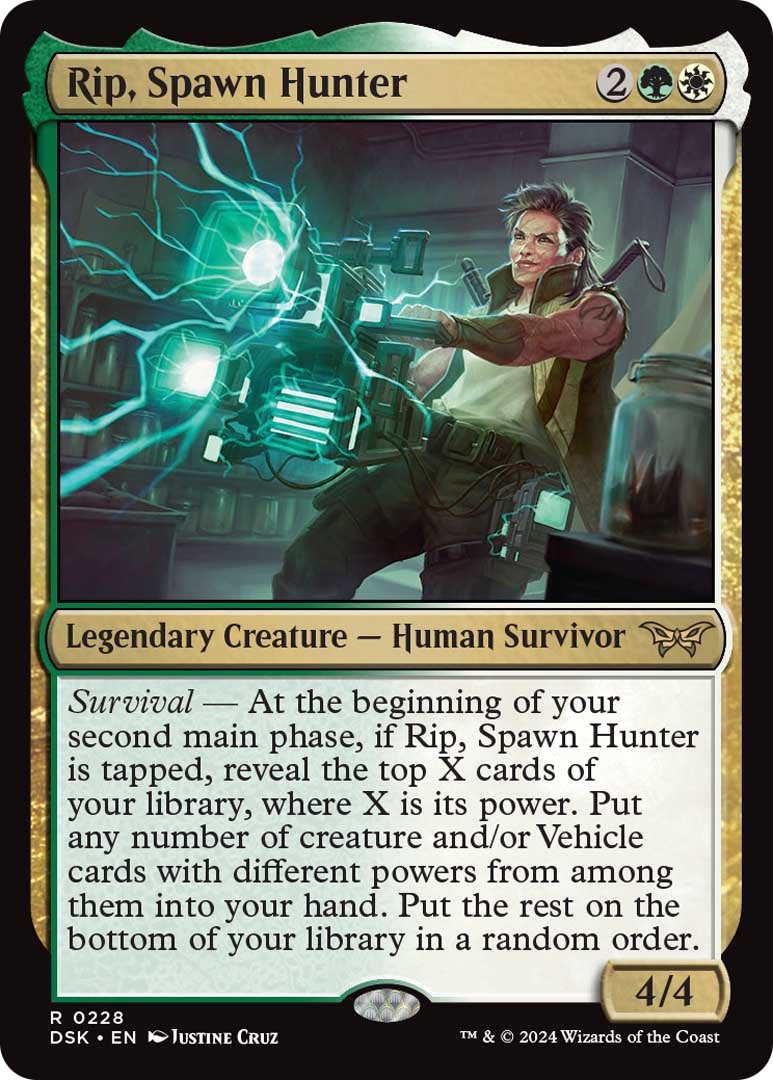
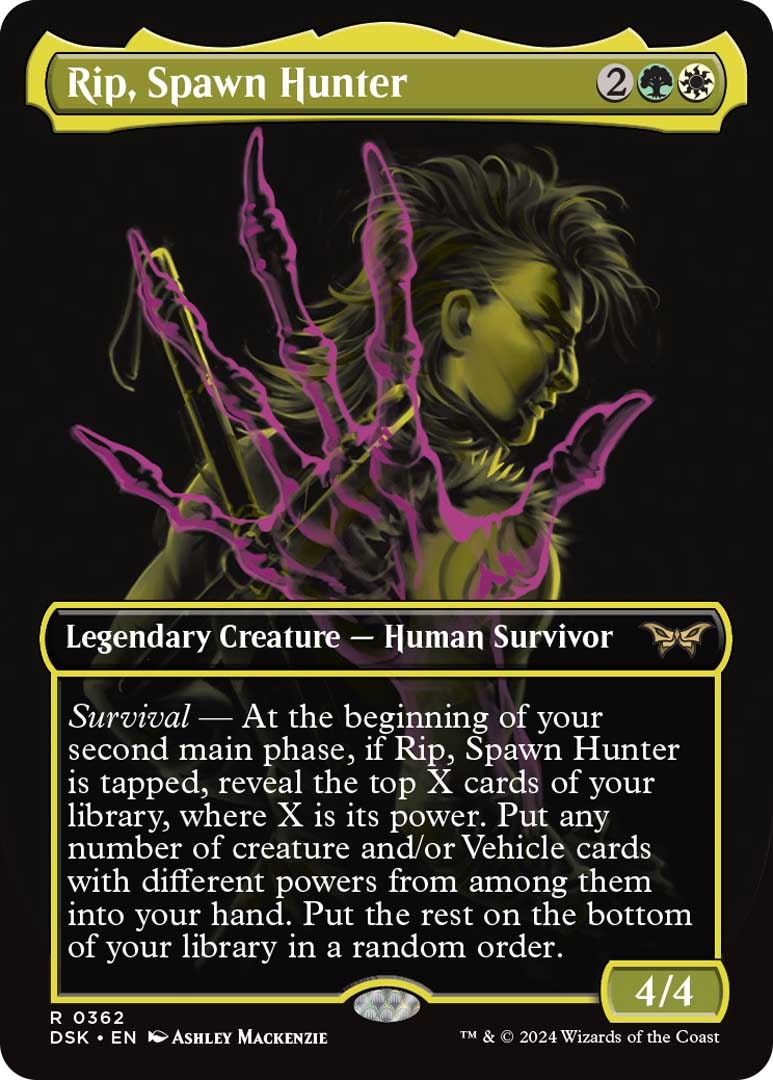

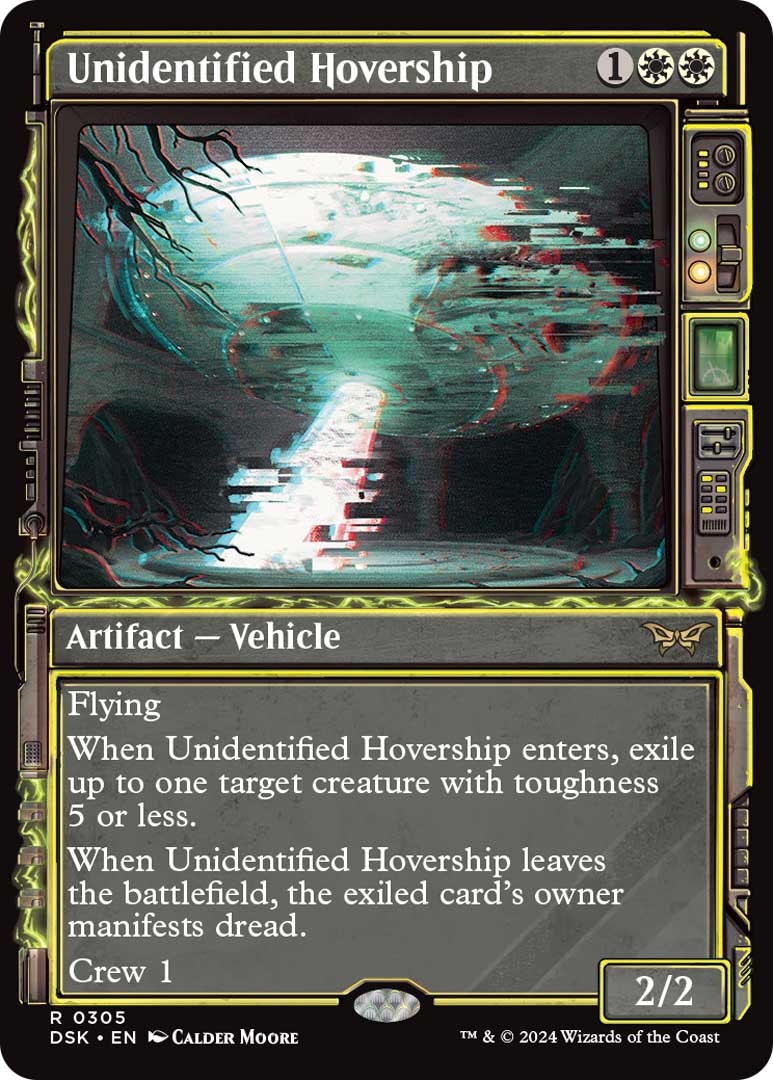
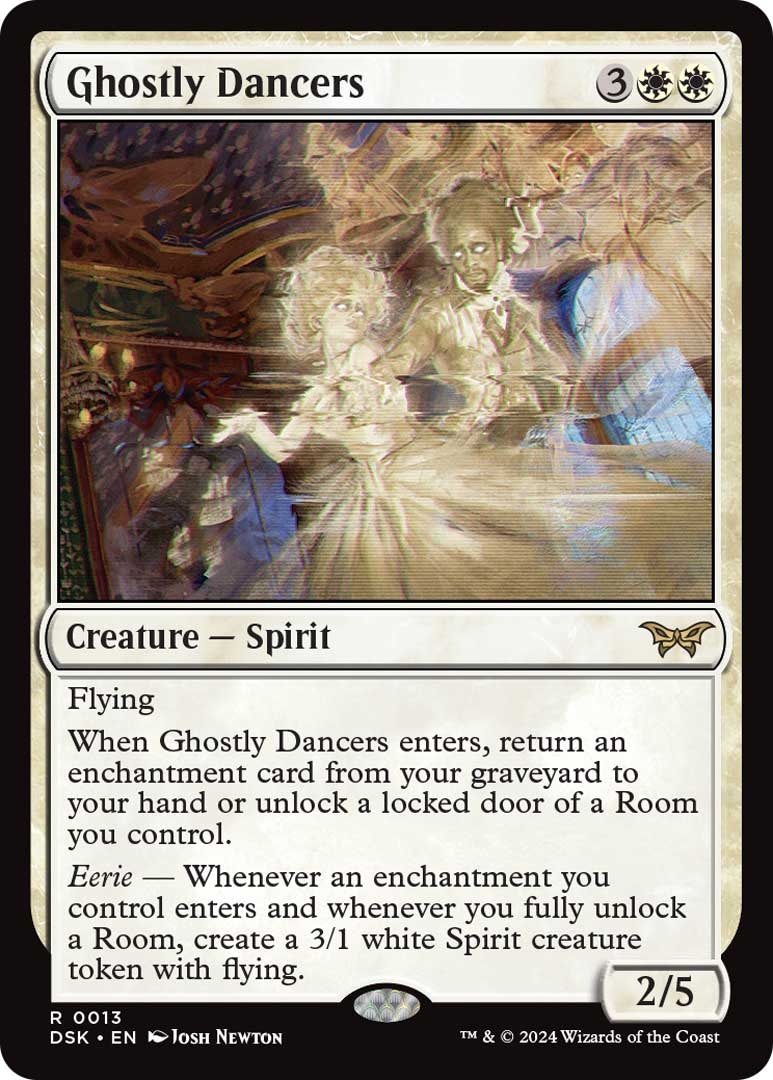

Inverse: To start, I want to ask, where did this idea first come from for Duskmourn to do a horror-focused set?
Emily Teng, worldbuilding design lead: We try to map out, years in advance, what sets we're going to be going to. For this year, we were like: Yeah, we're going to go to a cute animal world, and then, right afterward, we're going to do modern horror. I don't know who to blame for that idea, but it stuck.
People were interested in doing it because we've only had one real horror world, Innistrad. Innistrad horror is really gothic horror, and there's a bunch of horror that we just don't tap into with it, more modern influences. If I remember correctly, we deliberately wanted to come after Bloomburrow, because that's so cute and comforting. Then we're like: Well, let's test how much our audience will accept a total whiplash.
“Like a baby doll wielding a chainsaw.”
Annie Sardelis, senior game designer: When something's a nugget of an idea on a wall, it just takes enough people to be excited about it from all sides. It's like, okay, Design is hyped about it; they want to make more chainsaws. World Building is hyped about it; they want to draw spooky monsters or whatever. It just manifests into us actually making the thing.
Ovidio Cartagena, senior art director: Afterwards, we got into the how. Okay, this is haunted. How's it going to be haunted? Initially, we were going to be like: This is a big haunted house somewhere. Instead, we were like: Well, let's make it just a house and it's the size of a whole plane, which is a planet, and then we just went nuts with it. That gave us free rein to get wacky with designs and monsters and things that could happen here. Some things can't happen. Shakespeare in the Park can't happen in Duskmourn. It could plausibly happen in Innistrad. Some things absolutely can happen, like a baby doll wielding a chainsaw.
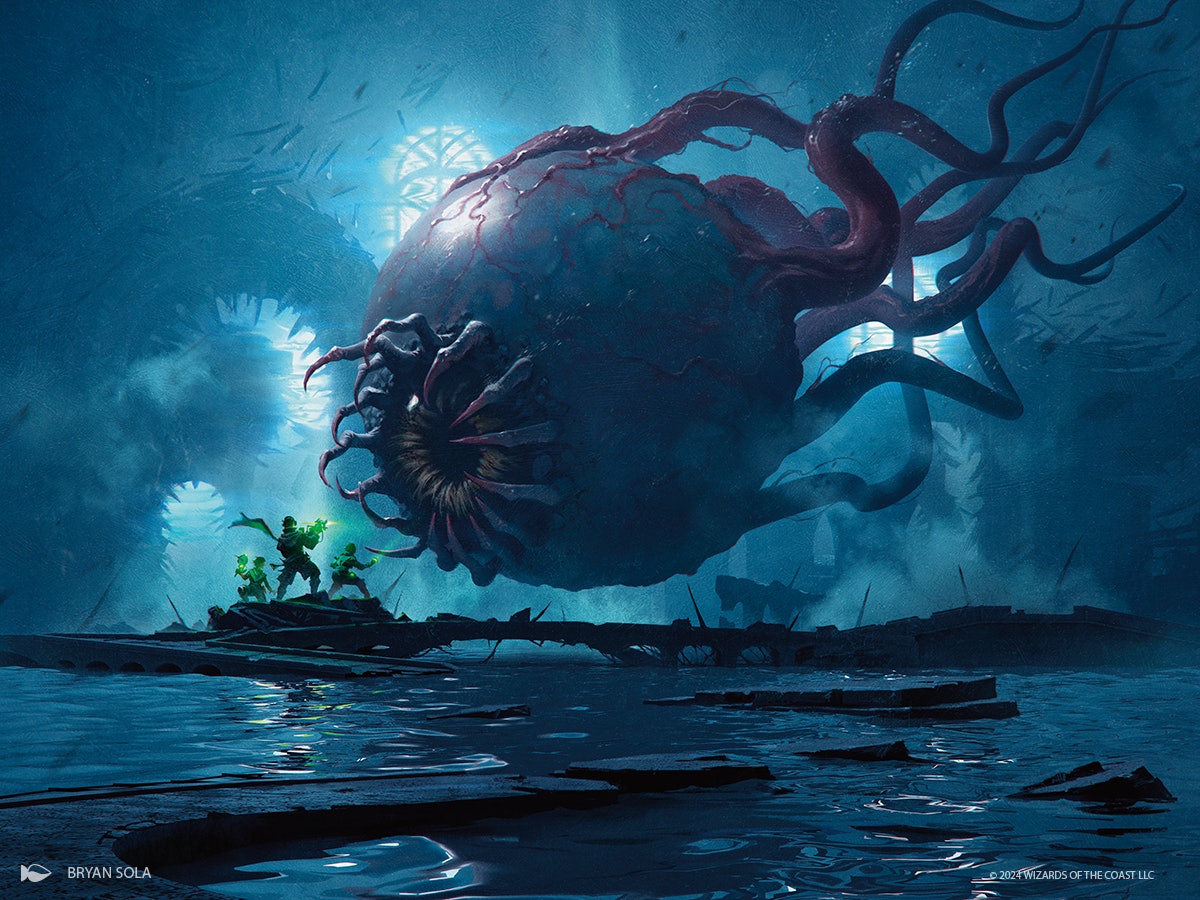
I'm curious how you landed on haunted house. Was that always the idea? Did it come after? Like, “Let's do a horror thing. Oh, haunted House would be cool”?
Emily Teng: Part of it was, we were trying to distinguish this from Innistrad. Also, we knew we were tapping into more modern horror from the ‘70s, ‘80s, and onwards. Haunted houses just show up everywhere. This creepy place that you walk into and then you get stuck in there and all sorts of spooky stuff happens.
We ran with the idea of a haunted house because there was a lot of fertile ground in there. All you really need to say for a haunted house is it's haunted. What's it haunted by? Well, it can be haunted by any number of things like ghosts, demons, an inhabitant who was, I don't know, buried in the walls and now comes out at night to watch you as you sleep.
One thing that I like about Magic is we don't have a special effects budget. It's not like we have to worry about how big we're making the house or how many rooms we want to design for it. That gives us the freedom to just expand it and make it as big as we want.
“The Room mechanic was our big shot at that and where we spent a bunch of time and iteration.”
Ovidio Cartagena: Even though there's a strong cinematic influence in the work, there are also several cues and ideas that inspired us from urban folklore, from literature.
Emily Teng: I like drawing from literature because it's a lot of really evocative words that put pictures in your mind, but it's easier to just build images off of those words. You're not fighting with existing visuals from other media, like comics, movies, and video games already, which have built-in visuals that people will automatically jump to.

Were there any specific books? Are there any books you talked about a lot that influenced this?
Ovidio Cartagena: I can tell you movements that we were influenced by. I've read a lot of the gothic stuff from the 1700s to the 19th century. I started reading all the descendants of all the people who were influenced by the Cthulhu mythos, cosmic horror, and so on. I think modern writers did a great job of mixing the daily with the cosmic, much more so than the people in the 1930s and 40s.
With films, yes we talk about the ‘80s and the ‘70s, but I always mention Giallo because I didn't want the set to look dreary. I wanted it to look vibrant. I wanted the color to be a source of horror, which is very tough to achieve. In Giallo cinematography, you really see that happen in a very good way.
Emily Teng: I'm really into creepypasta and liminal horror stuff. Even though this is based in the ‘80s, I still wanted to make sure it wasn't just stuck in the '80s so I incorporated some of those influences, as well.
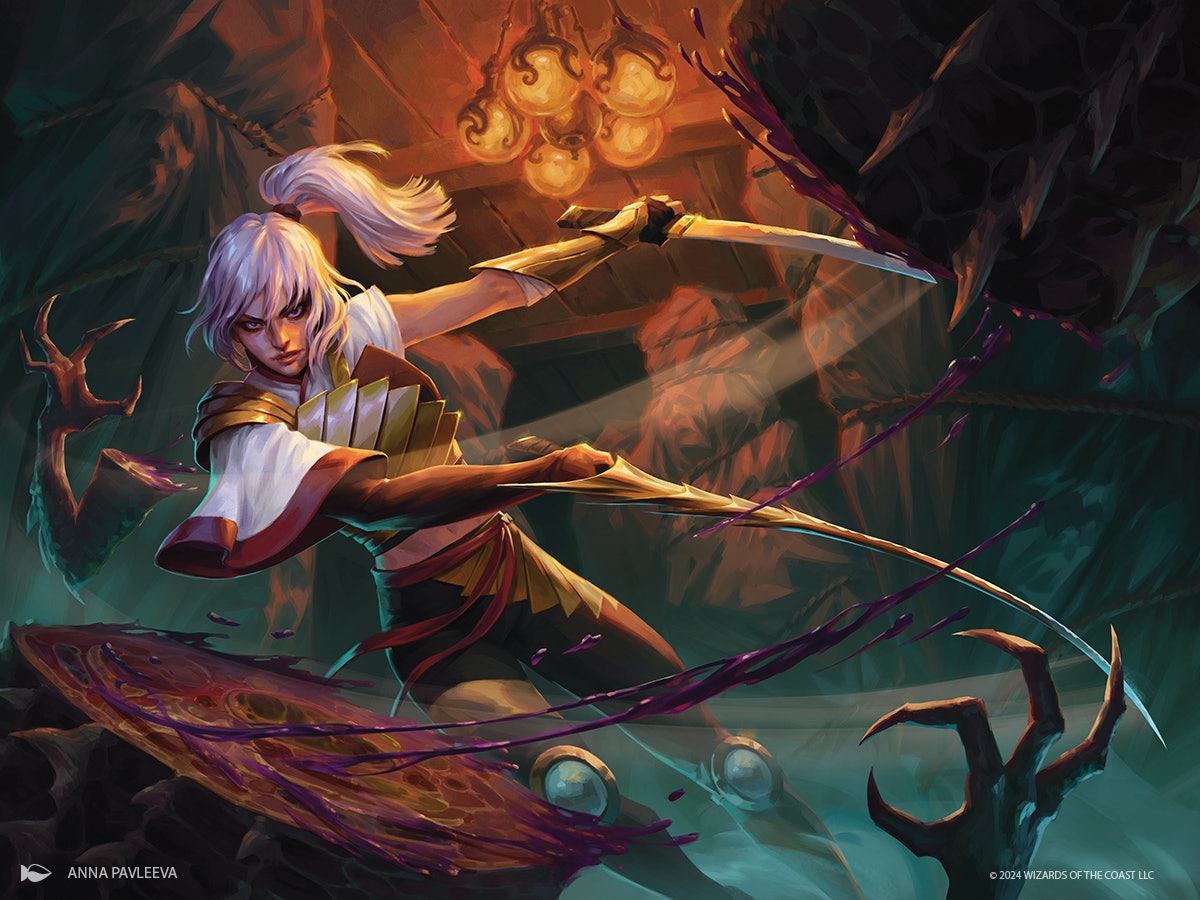
How did the genre of horror influence or inspire the mechanics of Duskmourn? Obviously, you have Rooms, which is a cool new card type, but talk to me about your favorite new mechanics and how they’re riffing on horror tropes and the genre in general.
Annie Sardelis: The Room mechanic was our big shot at that and where we spent a bunch of time and iteration. We took a lot of inspiration from Betrayal at House on the Hill when it comes to building out a huge room. With Enchantments, by the end of the game, you will have a bunch of stuff out that wasn't there when you first started, so we still were able to capture a bit of that.
Manifest Dread is another one that really hits on the whole, what's that thing? What's that face-down bump in the night?. With a lot of films, you don't see the monster until the very end and then you cross your fingers that it's cool and not cheesy. We have these little 2/2 face-down creatures that you can flip face-up using Manifest Dread. It can be anything in your deck. They could be literally anything at all. Maybe they're not even that scary; that's fine. Maybe they're from the Bloomburrow set because you’re playing Standard or something. I think that'll be very cute.
Another is Impending. The idea of suspense is super important to the genre. You're like on the edge of your seat, what's going to happen? We initially were like, let's just use Suspend since that was a returning mechanic, we didn't really explore much with it early on. We know how it works. We know how to make cards of it, but [game designer] Jules Robbins really took it to the next level being like, let's get these on the battlefield. Let's use time counters, which is reminiscent of suspend. You still get that feeling of suspense with Impending, where we have these really badass overlord creatures that are just massive baddies.
“There's a pretty cool rare blue and white Room that leans towards a controlling strategy using Eerie.”
Ovidio Cartagena: Rooms is my favorite because it was just completely novel. It's something I hadn't done before for Magic. I liked the idea of panning through and seeing scary stuff and putting Easter eggs of horror there for people to find. The dark mechanic of a room has an effect on you. You step into a haunted room, you have a feeling. That's the intention behind that.
Emily Teng: I really liked actually how we solved for Enchantment Creatures. There's a bunch of Enchantment Creatures in the set to help support the heavy Enchantment theme of the set. On the world-building side, we said that Enchantment Creatures are all physical manifestations of thoughts, dreams, fears that the house pulls out of your head and then gives physical form. The reason they're enchantment creatures and not just creatures, is just to show there's something a little extra, something more than normal about them. All because of the influence of Valgavoth, who controls the house and has this pervasive, malevolent psychic quality that spreads throughout the house.
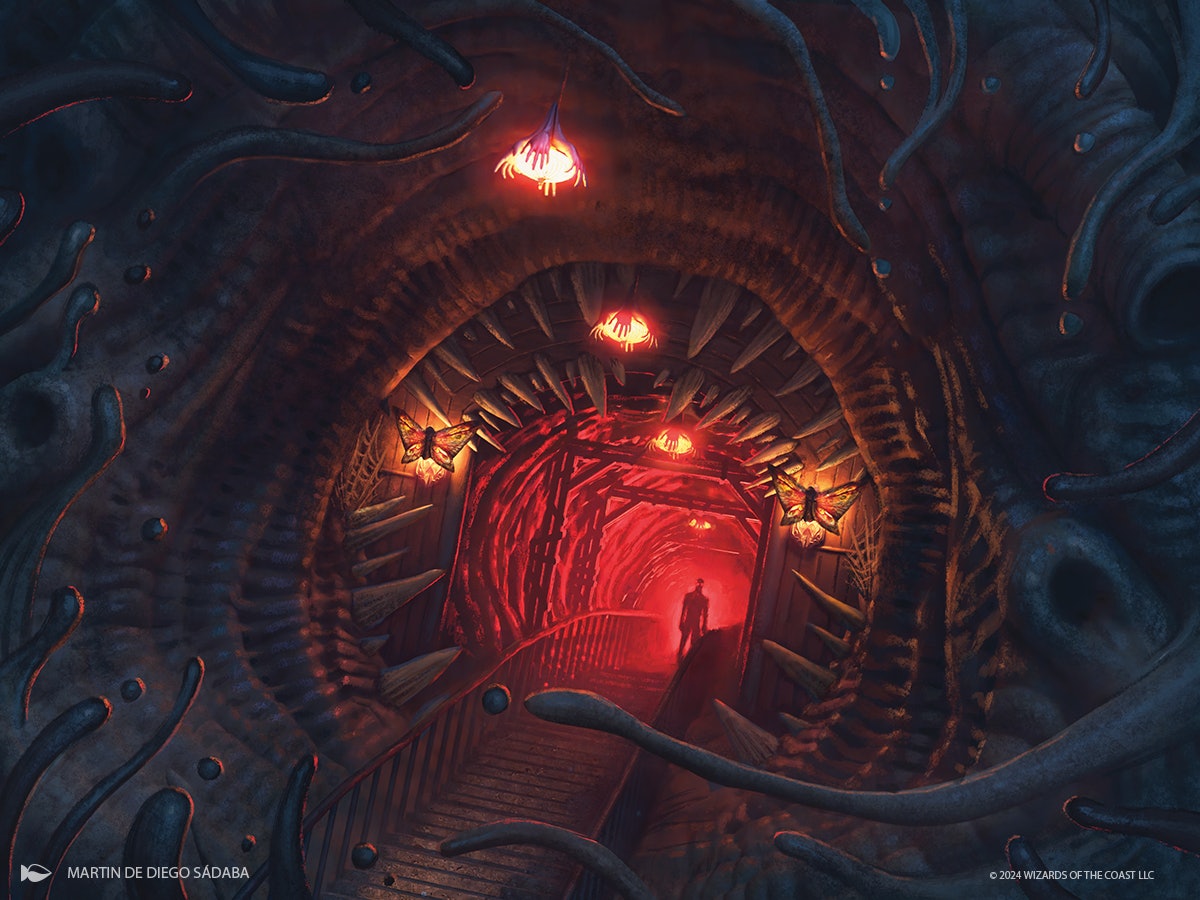
You mentioned Valgavoth and I have a question about him. He’s a moth and there's a theme of moths throughout the set. You brought back Aminatou, a character in Magic associated with moths; and the icon of Darkmourn is a moth. There's a lot of moths going on. How did that happen?
Ovidio Cartagena: There's a lot of mythology around the moth. It's a symbol we hadn't exploited much in Magic. Moths are cool and scary, but pretty. They have a bad rap, unlike butterflies. On a personal note, in my culture, there's folklore around the moth that it brings news to you, bad news, depending on how the moth looks. Where I'm from, the moths can get big. I remember seeing one as a kid and part of the wings was falling apart, but it could still fly. It's just a really scary thing to see if you're a young child. I think I brought a little bit of that with me.
When we decided on moths, it just took over. At first, I thought: How many variations can I really do on this? The answer is a ton of them. I'm also big a fan of cryptids, so I was thinking about the Mothman when we were doing Valgavoth. I was like, "Let's start here but let's take it up a notch. No, more. More, more, more!
Somehow we flooded the set with it and it doesn't feel boring.
In this article, we’re revealing a few new Duskmourn cards, so let’s talk about them. The first one is Unidentified Hover Ship, which is a really fun card. It's an alien vehicle. There's an abduction thing happening. What was the thought process behind the development of that card? And why are you excited about it?


Annie Sardelis: I think that was partially my fault. I'm going off my memory here, but from what I remember, it's like a big white flying creature. Every Magic set needs one of those, like Serra Angel or some beefy eagle thing from Tarkir or something. So I'm like, well what is that in here? It's not an angel or a bird. That ain’t spooky enough — especially a white bird. What's spooky? It's a UFO.
That card did change a lot from the earliest version. It has power two, but we do have a power two or less white/red archetype. That's probably why it ended up in that shape by the end.
Ovidio Cartagena: When it comes to our side, all we see is a temporary title in brackets. It says UFO. I was like: How are we going to do this? How's it going to work? Is it going to be metal? Is it going to have windows and so on? I was like, no, absolutely not. None of that. Just make it like a glowing, ghostly thing. It goes better with the set. Otherwise, you're going to have to imply that there's some alien in this set already.
My idea was, let's go and look at incidents where people have seen a UFO that is glowing and more spiritual, more luminous and ethereal, than actually something you can touch. I found the Rendlesham Forest incident in England back in the ‘90s and I went off of that.
Also, having it in the forest is cool. You don't know how it got all the way down there. It could have shown up. There's a lot of unanswered questions and I like that piece. It's pretty moody.
Emily Teng: Rather than just do a straight hovership, we tried to see what fantastical touches we could do. We took some inspiration from jellyfish to get the hover shape without directly saying this is a UFO.
Another card we have is Rip, Spawn Hunter. It’s got a Ghostbusters-esque art thing happening. What was the thinking with this character? And also, do you see a lot of Commander potential with this guy?


Annie Sardelis: This design is pretty sick (it's my first time seeing it). Our green/white limited archetype is the survival one where you get lots of people. With survival, you want your guys to be tapped at the end of combat, but sometimes they'll just die in combat. That's why you need these vehicles that can go fetch up. One of those vehicles, I guess, being this Unidentified Hover Ship. You can get in the UFO in order to enable your survival ability, which is pretty cute.
I think it would be a pretty niche Commander deck if someone would to build it, but I'd be interested to see how they can cheat different tap matters.
Our final exclusive is Ghostly Dancers, another rare creature. Talk to me about this card.


Ovidio Cartagena: Early on in the process, we had a concept of a ballroom where there were apparitions on the floor; reflections. In tandem, we were developing white-aligned spirits to be the calmer sort, the ones who have good intentions.
These two concepts evolved into what we see in the card, ethereal dancers who help you explore the house and aid you in the game. The art by the great Josh Newton is a highlight here, he’s one of the artists who best captures the weirdness of Duskmourn.
Annie Sardelis: There's a pretty cool rare blue and white Room that leans towards a controlling strategy using Eerie. I'm not sure if it's been previewed yet, but Ghostly Dancers are another piece of that game plan, generating you value both when it enters the battlefield and turn over turn with the Eerie trigger. The stats moved to be more defensive (2/5) to pair better with that strategy as well. The design of Ghostly Dancers reminds me a lot of Archon of Sun's Grace from the Theros Beyond Death set, which also nets you a lot of flying power.
I only have time for one more question, so I have to ask about Universes Beyond. This new set riffs on a lot of classic horror movies. Did the process of designing it make you want to directly adapt any horror franchises into a Universes Beyond set? Will we ever see a Stephen King set in Magic the Gathering, for example?
Ovidio Cartagena: There is some coming down the line I can't talk about it. There's a wish I had and it got fulfilled, so I can't say it.







